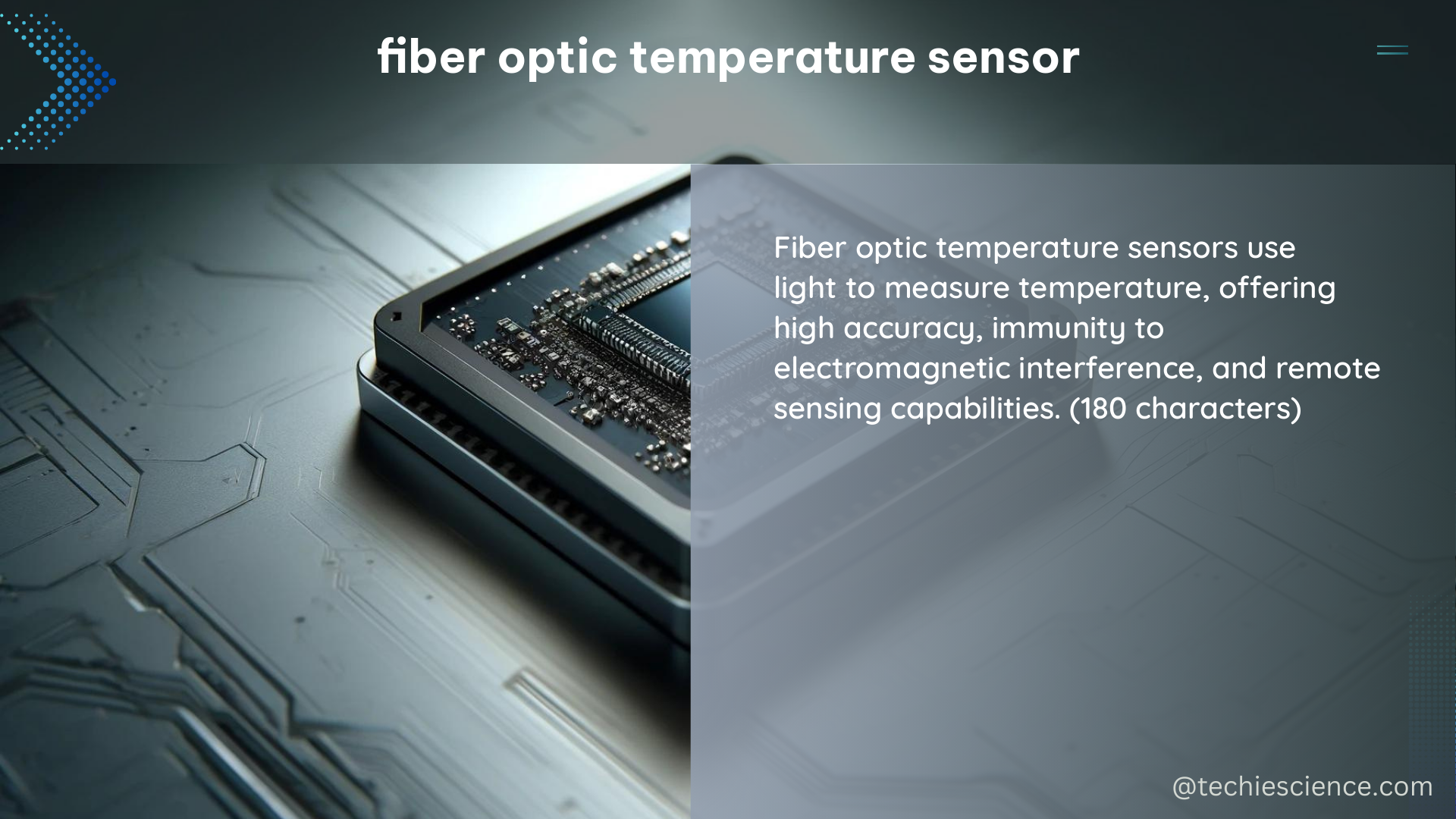Fiber optic temperature sensors (FOTS) are advanced devices that measure temperature by detecting changes in the properties of light as it travels through an optical fiber. These sensors offer a range of advantages over traditional temperature measurement techniques, including high accuracy, flexibility, resistance to electromagnetic interference, and the ability to measure multiple physical quantities using a single optical interrogator.
Understanding the Principles of Fiber Optic Temperature Sensors
FOTS operate on the principle of the thermo-optic effect, where changes in temperature cause variations in the refractive index of the optical fiber material. This change in refractive index alters the propagation of light through the fiber, which can be detected and correlated to the temperature.
One of the key features of FOTS is their linear dependence between temperature and the measured wavelength. A change of 1 degree Celsius typically causes a change in the wavelength by 0.007-0.01 nanometers (nm). This linear relationship is crucial for accurate temperature measurements and allows for straightforward calibration of the sensor system.
Sensor Characteristics and Performance Metrics

The performance of FOTS can be quantified through various metrics, including accuracy, precision, and measurement range. Let’s explore these in more detail:
Accuracy
The temperature accuracy of FOTS is typically guaranteed to be within 1°C, with a typical accuracy of less than 1°C. This high level of accuracy is achieved through careful design and calibration of the sensor system.
Precision
The temperature precision of FOTS is guaranteed to be within ±0.3°C for a measurement range of -40 to 85°C, with a typical precision of ±0.1°C for the same range. This high level of precision ensures reliable and consistent temperature measurements.
Measurement Range
FOTS can be designed to operate over a wide range of temperatures, from cryogenic levels to high-temperature environments. The specific measurement range depends on the materials and construction of the sensor, as well as the intended application.
Sensor Design and Configurations
FOTS can be designed in various configurations to suit different applications. One example is a novel optical temperature sensor developed for minimally invasive measurement of local tissue temperature in hyperthermia cancer treatment. This sensor uses a multimode plastic optical fiber with a polymethyl-methacrylate (PMMA) core of 980 μm and a silicone layer (fluorinated polymer cladding of a 20 μm) deposited around the fiber tip.
This sensor design allows for monitoring temperatures in the desired range of 35 to 45°C with a resolution of about 0.1°C, making it suitable for biomedical applications where precise temperature measurement is crucial.
Applications of Fiber Optic Temperature Sensors
FOTS find a wide range of applications due to their unique advantages. Some of the key application areas include:
-
Biomedical: FOTS can be used for monitoring the temperature of the human body, as they exhibit high sensitivity compared to fiber Bragg gratings (FBGs) and a wide dynamic range. They are particularly useful in hyperthermia cancer treatment, where precise temperature monitoring is essential.
-
Building Automation: FOTS can be employed to measure the temperature inside a building envelope, providing valuable data for energy management and optimization.
-
Industrial Processes: FOTS can be used to monitor the temperature of various industrial processes, such as in furnaces, reactors, and other high-temperature environments, where they offer resistance to electromagnetic interference.
-
Aerospace and Defense: FOTS are suitable for use in aerospace and defense applications due to their ruggedness, reliability, and ability to operate in harsh environments.
-
Energy and Power: FOTS can be used to monitor the temperature of electrical equipment, transformers, and power lines, helping to prevent failures and ensure the safe operation of power systems.
Conclusion
Fiber optic temperature sensors are advanced and versatile devices that offer a range of benefits over traditional temperature measurement techniques. With their high accuracy, precision, and resistance to electromagnetic interference, FOTS are well-suited for a variety of applications, from biomedical to industrial and beyond. As technology continues to evolve, the capabilities and applications of FOTS are expected to expand, making them an increasingly valuable tool in the world of temperature measurement and monitoring.
References
- Fiber Optic Temperature Sensor for Minimally Invasive Measurement of Local Tissue Temperature in Hyperthermia Cancer Treatment
- Fiber Optic Temperature Sensor Based on Multimode Plastic Optical Fiber for Biomedical Applications
- Fiber Optic Temperature Sensor for Monitoring Temperature in Hyperthermia Cancer Treatment

The lambdageeks.com Core SME Team is a group of experienced subject matter experts from diverse scientific and technical fields including Physics, Chemistry, Technology,Electronics & Electrical Engineering, Automotive, Mechanical Engineering. Our team collaborates to create high-quality, well-researched articles on a wide range of science and technology topics for the lambdageeks.com website.
All Our Senior SME are having more than 7 Years of experience in the respective fields . They are either Working Industry Professionals or assocaited With different Universities. Refer Our Authors Page to get to know About our Core SMEs.